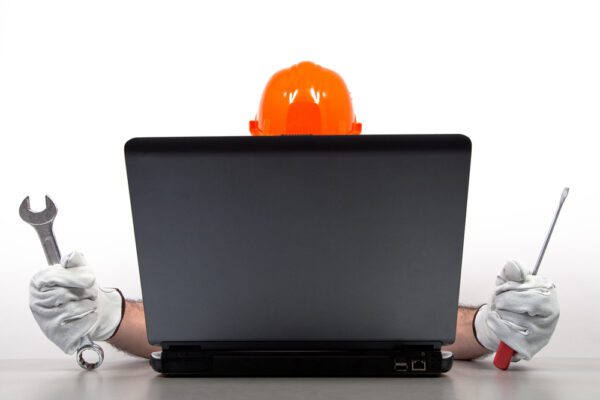
Computerized maintenance management system (CMMS) software is a powerful tool that can transform the way maintenance teams work, particularly in organizations still relying on manual processes. But while maintenance leadership may recognize the value of a CMMS, technicians often see things differently.
Many organizations struggle with how to get maintenance staff to use CMMS software, running into resistance that can put the entire implementation at risk. In this article, we’ll provide strategies for gaining user buy-in and ensuring successful CMMS user adoption.
What is CMMS User Adoption?
CMMS user adoption is the process of getting new users to start using a new CMMS and keep using it long term. It is the journey your team takes from becoming familiar with the CMMS to seeing the value in how it makes their work easier and making it a part of their daily routine. This acceptance to a new way of doing things is what is meant by “adoption”.
Why User Adoption Matters in CMMS Implementation
To put it simply, your CMMS implementation will only be successful if your team actually uses the software. While leadership may see an opportunity to improve productivity, streamline processes, and reduce maintenance costs, these goals are unlikely to be shared by the maintenance team. Instead, they may view the CMMS as a disruption that forces them to change the way they work, leading to frustration, resistance, and resentment.
Complicating the issue is that, initially, a CMMS may actually decrease productivity as maintenance staff gets up to speed with new technology, workflows, and expectations. This may reinforce strong opinions that the system is burdensome and adds unnecessary complexity to their work. Without a plan to address these perceptions, poor user adoption can reduce your ROI and increase the time it takes to achieve your maintenance goals. With the right strategies, however, you can overcome these challenges and set your team up for long-term success.
Learn how to calculate CMMS ROI
Common Challenges When Implementing CMMS Software

From management’s perspective, a CMMS is a valuable tool that should make life easier for the maintenance team, so it can come as a surprise when the system is met with resistance.
It is important to recognize that most people don’t resist change just for the sake of it – there is usually an underlying reason. Understanding these reasons is critical, because it allows leadership to address concerns directly and build trust during the transition. Maintenance staff may be reluctant to adopt a CMMS for several common reasons:
Perceived Burden of Data Entry
Technicians may perceive the CMMS as adding administrative work. Today’s organizations value data-driven decision-making, which means higher data entry requirements for CMMS end users.
Technicians may worry that data entry will be cumbersome and increase administrative work. It also takes them away from what they do best: performing maintenance and making repairs. This can be especially worrisome for employees without basic computer skills.
Lack of Experience with Technology
Technicians may lack experience with digital tools. Organizations that currently rely on paper-based maintenance management may have employees that are uncomfortable using new technology.
After all, making the transition from pen and paper to a fully computerized system is a big leap. Even as technology becomes more common, a significant portion of employees still lack basic computing skills.
Fear of Replacement
Technicians may fear that CMMS software may one day replace them. This stems from the concern that if all of their knowledge, gained over years of experience, is entered into a computerized system, they will no longer be valuable to the organization. Therefore, employees may withhold information from the software or refuse to use it altogether.
Maintaining the Status Quo
Technicians may prefer to stick with familiar processes. The proverb, “If it ain’t broke, don’t fix it” captures this mindset. Staff may be satisfied with the way things are working right now and see no reason for a change. This sense of tradition can make workers resistant to adopting a CMMS.
Past Negative Experience
Technicians may be wary of new CMMS software because of past experiences. If employees have previously used a CMMS or other maintenance software that was difficult, unreliable, or poorly implemented, they may be hesitant to invest time and effort in a new system.
Negative experiences can create skepticism about the benefits of the software and reinforce resistance, making it essential for management to acknowledge these concerns and demonstrate how the current CMMS is different.
CMMS User Adoption Strategies
The level of user adoption can depend on how the software is implemented. Common user adoption strategies are an instant switch, parallel use, and a phased approach. Below is a summary of each:
| User Adoption Strategy | How It Works | Benefits | Challenges |
| Instant Switch | The organization fully transitions to the new CMMS on a set date. |
|
|
| Parallel Use | The old system and new CMMS are run side-by-side for a period, allowing staff to cross check and learn gradually. The old system remains fully active as a safety net. |
|
|
| Phased Approach | Staff adopts the CMMS gradually, starting with core functionality and simple tasks, and expanding use over time. Reliance on the old system is reduced as the CMMS takes over. |
|
|
Based on his CMMS consulting experience FTMaintenance Select Product Expert Dave Dulak, recommends a phased user adoption strategy.
“I’ve always been a proponent of implementing a system in the simplest form with the easiest processes possible.”
He advises that organizations should take “baby steps” when integrating the CMMS into their processes. Once the low-level, simple goals have been achieved, more advanced use can be introduced.
Best Practices for User Adoption of Maintenance Management Software

Implementing a CMMS is only half the battle. Ensuring that your team actually uses the system is critical to driving results and achieving your maintenance goals. The following best practices help organizations overcome resistance and create long-term adoption of the CMMS.
Understand Your Maintenance Culture
Your maintenance culture shapes the behaviors and mindset of your team. Traditional maintenance culture is often reactive, leaving employees feeling like they’re constantly putting out fires. A shift toward a more proactive approach not only improves equipment reliability but also gives employees a clearer sense of purpose and control over their work.
When maintenance staff see how a CMMS supports proactive strategies such as scheduling routine tasks, tracking equipment health, and preventing unexpected breakdowns, they are more likely to view the system as a tool that enables better work rather than an additional burden. Aligning CMMS adoption with a proactive maintenance culture can inspire your team to embrace the software and take ownership of its benefits.
Communicate Personal Benefits
With such a focus on the CMMS, it can be easy to overlook change from your team’s perspective. Technicians are not interested in the software’s features – instead, they want to know how the system will make their lives better.
To encourage maintenance teams to use the CMMS, focus on communicating the ways in which it will be personally beneficial. This may include benefits such as:
- Automating administrative tasks to reduce repetitive data entry and free up time for hands-on maintenance.
- Minimizing paperwork by replacing forms, logs, and spreadsheets with digital documents and records.
- Simplifying daily responsibilities like tracking work orders, scheduling tasks, prioritizing maintenance activities, and staying organized.
- Preventing emergency breakdowns by staying ahead of issues with automated notifications to reduce last-minute emergency repairs.
- Providing more visibility into what work is coming up, overdue, and completed.
By framing the CMMS in terms of personal benefits rather than technical features, you help your team see the value in adopting the new system.
Involve Employees in the Selection Process
As part of the CMMS software evaluation process, you should gather input from all maintenance stakeholders, including your team. While management focuses on how the system will increase reliability, reduce downtime, and lower maintenance costs, your workforce will be the primary users.
Involving employees early through software demos, evaluation sessions, or even early access to the system gives them a chance to provide feedback, voice concerns, and influence the implementation. Even small decisions can go a long way in making employees feel like their input is valued and respected.
This participation not only ensures the chosen CMMS meets real-world needs, but it also helps turn team members into advocates for the system, reducing resistance and building buy-in before they are expected to use it.
Read Blog Post: What to Expect from a CMMS Software Demonstration
Amp Up Training
Training provides a boost in user adoption when aligned with how your team learns best. Some employees prefer traditional classroom-style learning environments while others are more comfortable with digital learning methods. Depending on the vendor, training formats may include:
- In-person training that provides technicians with valuable face time with a knowledgeable, experienced software trainer.
- On-demand videos that allows users to learn how to use system features at their own pace.
- Live, web-based training where users can follow along with a live instructor from the comfort of their own workspace or facility.
Training can come from your internal team as well. Tech-savvy employees can serve as an internal support network for others. Power users and system administrators can also make themselves available to answer questions, share tips via email, or hold lunch-and-learn sessions, if appropriate.
Learn more about the role of power users in CMMS implementation
Update Documentation
When first launching the system, vendor-provided or internally-created documentation is accurate and up to date. However, as the software is updated and you increase your use of advanced features, it is easy for documentation to become out of date. This creates frustration when what users see in the software does not match the training materials.
Keeping user documentation up-to-date ensures employees have reliable reference materials and reduces the risk of resistance due to uncertainty or misinformation.
How to Maintain Momentum After Initial CMMS Launch
Even if your implementation starts strong, it is common for enthusiasm to wane over time. CMMS user adoption should be treated as an ongoing responsibility that requires regular attention, and not just a one-time effort. The following strategies can help keep employees engaged and increase the chances of long-term success:
- Provide ongoing training to reinforce correct usage, introduce new features and workflows, and address any questions.
- Share and celebrate your team’s success by highlighting how the CMMS has helped your team improve response time, reduce downtime, and increase productivity.
- Empower power users as software champions that can provide ongoing support, demonstrate best practice use, mentor other users, and continue to advocate for using the CMMS.
- Regularly review workflows and processes to observe how maintenance tasks are actually performed in the field and adjust the CMMS to support practical use.
- Ask for feedback from your employees and encourage them to suggest improvements, report issues, or request new features.
- Track and share performance metrics that help your team connect their work to real improvements.
When CMMS user adoption is viewed as a continuous process, you keep your team engaged and greatly increase the chances of successful user adoption.
Drive CMMS User Adoption with FTMaintenance Select
We understand that CMMS implementation can be tricky, especially when it comes to user adoption – but you don’t have to tackle it alone. FTMaintenance Select is an intuitive, easy-to-learn CMMS solution designed to get your team up and running with minimal training.
With complimentary implementation services, user training, and ongoing support, your maintenance staff will confidently adopt FTMaintenance Select from day one and continue to build long-term success. Request a demo today to see why organizations choose FTMaintenance Select as their CMMS solution.